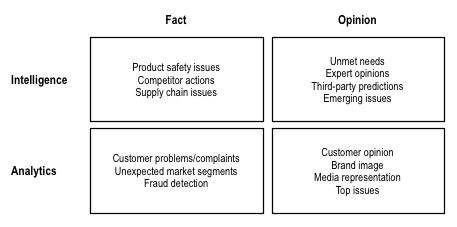In my last post, I suggested that intelligence and analytics are two angles on the same challenge: developing the information value in available data. You're probably already looking—sorry, listening—for useful information online. Rather than thinking of intelligence and analytics as separate specialties, let's approach them as two lenses that might help us find information in data.
I'm going to risk a small definition here; if I'm going to write about intelligence and analytics, it would help if I assert that these aren't two words for the same thing. Proposing a formal definition isn't my point, so let's think about it this way: We do a lot of quantitative analysis these days. We care about the results because they present trends or aggregate data points in some way. For the purposes of this discussion, that's analytics. Other times we care about individual facts, regardless of the quantitative view. That's intelligence (cue James Bond theme).
For example, you might be interested in the most popular adjectives used to describe your product or brand. You care about the results because they represent mass opinion. That's analytics. Conversely, if you discover a death caused by your product, that fact is important regardless of how many people are talking about it. That's intelligence.
Yes, it's a little messy. The point is to notice what we've been missing, not to perfect the language.
What do people say?
Let's apply this to the familiar topic of listening in social media. People say all sorts of things online, but when we start analyzing their meaningful statements, they fall into two categories: statements of fact (which may be false) and statements of opinion.
We spend a lot of time on the notion of analyzing opinions. Most of the usual metrics help us understand trends in the opinions expressed in a large collection of comments. But what about facts? What do we do about them? They don't really fit into a market research paradigm, but some of them may be important to the business. We need to use a different lens.
It must be serious; he has a matrix
In proper consultant fashion, I decided to see what happens when we put these two ideas in a matrix. We use our intelligence and analytics lenses to look at statements of fact and statements of opinion online. Remember, analytics (in this discussion, at least) is about aggregate data, while the intelligence lens can pick up isolated signals. The examples in the boxes are illustrative; I'm sure you can think of more.

Think about the usual discussion of listening in social media. How much of it focuses on measuring customer opinion and brand image (including every discussion of the accuracy of sentiment analysis)? How much more value could we uncover if we asked more questions of the same data? Are you looking for the important signals that don't show up in a Top 10 chart?
This is another piece of the Omniscience framework I'm working on. It starts with four simple thoughts, and it all comes together eventually—I hope.

This is a great article for helping me apply some analytics to my thinking process. Sometimes I want to just do what I want and don't look at what is actually working or not working.